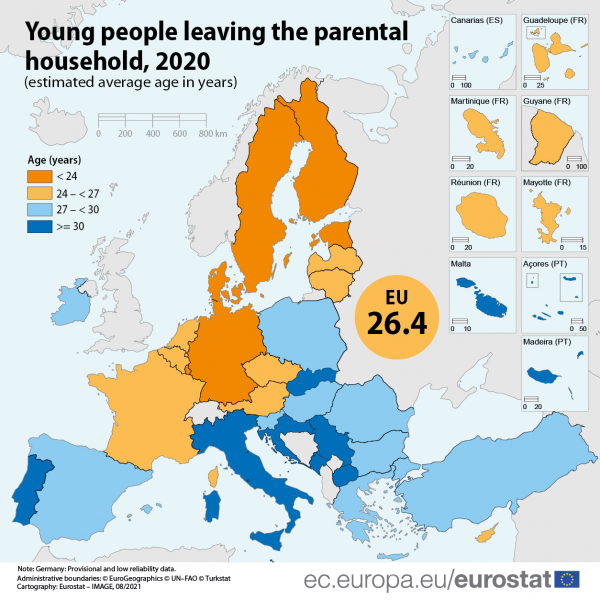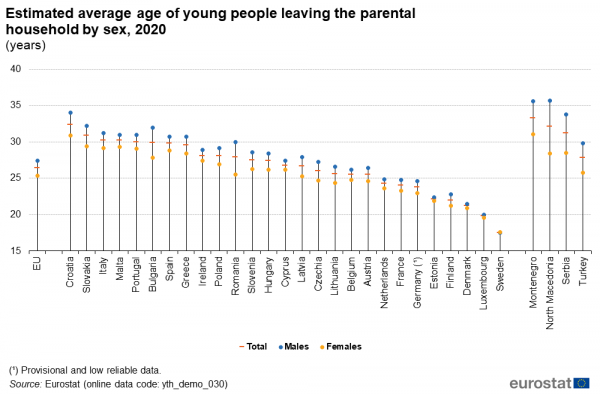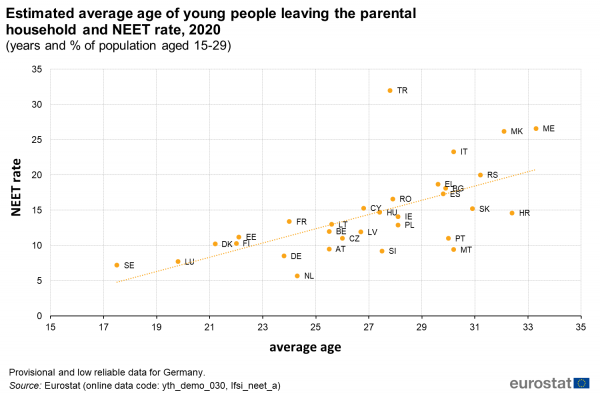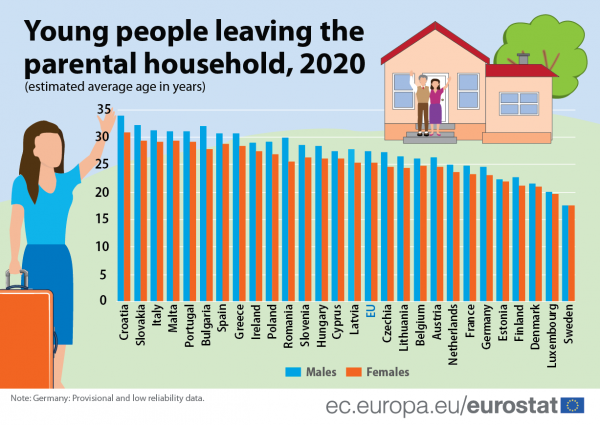Archive:Age of young people leaving their parental household
Data extracted in August 2021
Planned article update: August 2022
Highlights
Leaving the parental home is considered a milestone in the transition from childhood to adulthood. The reasons behind this step may vary from being materially independent to studying, working, moving in with a partner, getting married and having children, etc. However, the path to independence may not be straightforward and may occur at different ages across countries, as demonstrated in this article. This disparity may reflect the differences in the challenges that young people face across Europe, as well as the diversity of cultural differences between countries.
This article presents data on the average age of leaving the parental home in the European Union (EU) and in the EU Member States, as well as the candidate countries Montenegro, North Macedonia, Serbia and Turkey. Special attention is given to geographical and gender differences, as well as on the developments over time.
Full article
Geographical differences
As shown in Map 1, in 2020, the average age of young people leaving their parental home in the EU was 26.4 years. This average, however, varies a lot among the EU Member States. Croatia, Slovakia, Italy, Malta and Portugal recorded the oldest average ages of leaving the parental home, with all five in the category 30 years and over. By contrast, Germany, Estonia, Finland, Denmark, Luxembourg and Sweden showed the youngest average ages at less than 24 years. The lowest average age of young people leaving their parental household was observed in Sweden (17.5 years) and Luxembourg (19.8 years), while the highest was found in Croatia (32.4 years). Furthermore, including the non-EU countries, it appears that young people in the Western Balkans leave their parental home later than in the other countries, particularly in Montenegro, where this occurs at the age of 33.3 years; North Macedonia and Serbia follow with ages of 32.1 and 31.2 years, respectively. Moreover, looking at Map 1 from a broader perspective, it is clear that in most northern and western countries, young people left their parental home on average in their early to mid-twenties, whereas in most southern and eastern states in their late twenties or even early thirties.

Source: Eurostat (yth_demo_030)
Gender differences
In almost all of the countries studied, as well as at EU level, young women left the parental home earlier than young men (see Figure 1). The only exception to this pattern in 2020 was Sweden, where men did so at a slightly younger age than women (0.1 years difference). Furthermore, in eight EU countries (Croatia, Slovakia, Bulgaria, Italy, Malta, Portugal, Spain and Greece), men left their parental home on average after the age of 30. By contrast, women moved out of their parent's home after this age in only one country, namely in Croatia.

Source: Eurostat (yth_demo_030)
In 2020, the gender gap in the average age of leaving the parental home was 2.0 years at the EU level. It was the largest in Romania (4.5 years), Bulgaria (4.2 years) and Croatia (3.1 years). Considering the candidate countries, the gap was even longer in North Macedonia (7.3 years) and Serbia (5.3 years). By contrast, the gap was the smallest in Sweden (0.1 years), the only country where women left home later than men, followed by Luxembourg (0.4 years) and Estonia (0.5 years). Furthermore, there is a strong positive correlation between the average age of young people leaving their parental household and the size of the gender gap: in the countries where the average age of young people leaving their parental household is higher, the gender gap is wider.
Development over the years
Figure 2 presents the long-term evolution of the average age of young people moving out from the parental household at EU level. Focusing on men, the age of moving out reached 28.0 years in 2006, this was its highest point since the beginning of the time series in 2002. Hereafter, this age started to decline (by 0.1 years per year on average) reaching its lowest point in 2019 of 27.1 years. Then in 2020, the age of men leaving the parental home moved up by 0.3 years, which was the most sizeable increase since 2005. The long-term evolution of the age of women leaving the parental household does not reveal as much fluctuation over the years; it only ranged between 25.1 and 25.5 years; nonetheless, this age increased by 0.2 years between 2019 and 2020, which was also its largest rise since 2005. This latest development might reflect the situation revolving around the COVID-19 pandemic, which might have led young people to reconsider moving out and remaining a bit longer at their parent’s home.

Source: Eurostat (yth_demo_030)
In 12 EU countries, as shown in Figure 3, the average age at which the young population leave their parental household decreased over the course of the ten-year period between 2010 and 2020, with the largest decreases recorded in Luxembourg (-6.4 years), Sweden (-2.8 years) and Estonia (-2.3 years). Slovenia also knew a relatively sizeable decrease, of 2.0 years. This average age also increased in 12 EU countries, but the increases were less significant than the decreases. Ireland (+3.0 years), Spain and Croatia (+1.4 years for both) experienced the highest increases between 2010 and 2020. In addition, Greece and Portugal also recorded increases of more than 1.0 years over this period. Finally, in Bulgaria, Austria and Denmark, the age of young people leaving the parental home remained unchanged at 29.9, 25.5 and 21.2 years, respectively (although it varied to some extent over 2010-2020).

Source: Eurostat (yth_demo_030)
Young people in the majority of the EU Member States (18 countries exactly) had an increase in the age of leaving the parental home in the one-year period between 2019 and 2020. The most substantial increases, of more than 0.5 years, were found in Ireland (+1.3 years), Portugal (+1.0 years), Greece and Poland (+0.7 years for both), and the Netherlands and Croatia (+0.6 years for both). In Slovakia, the age of moving out remained stable between 2019 and 2020, while in eight EU countries this age declined. The largest declines were found in Lithuania, Cyprus, Sweden and Luxembourg (-0.3 years for each).
The interplay with NEET
Another relevant finding is that countries, where young people leave the parental household at an older age, are more likely to have a higher share of young people neither in employment nor in education and training (NEET). The association between those two indicators is shown in Figure 4. For example, young people in Luxembourg and Sweden left the parental home at a younger age on average than their peers in the other countries. At the same time, Luxembourg (7.7 %) and Sweden (7.2 %) recorded some of the lowest NEET rates. On the other hand, the NEET rates in Montenegro (26.6 %) and North Macedonia (26.2 %) were among the highest, and at the same time, young people in those two countries had the highest age of leaving the parental home.

Source: Eurostat (yth_demo_030), (lfsi_neet_a)
Source data for graphs
Data sources
Source: Statistics presented in this article are derived from the European Union Labour Force Survey (EU-LFS). The EU-LFS is the largest European household sample survey providing quarterly and annual results on labour participation of people aged 15 and over. It covers residents in private households and excludes those in collective households. Conscripts in military or community service are not included in the results. The EU-LFS is based on the same target populations and uses the same definitions in all countries, which means that the results are comparable between the countries.
Reference period: Yearly results are obtained as averages of the four quarters in the year.
Coverage: The results from the EU-LFS currently cover all European Union Member States, the EFTA Member States of Iceland, Norway, Switzerland, as well as the candidate countries Montenegro, North Macedonia, Serbia and Turkey. For Cyprus, the survey covers only the areas of Cyprus controlled by the Government of the Republic of Cyprus. However, EU-LFS household data are not available for Iceland, Norway, Switzerland. This is the reason why statistics are not available in this article for these three countries.
Country note: In Germany, since the first quarter of 2020, the Labour Force Survey (LFS) has been integrated into the newly designed German microcensus as a subsample. Unfortunately, for the LFS, technical issues and the COVID-19 crisis has had a large impact on the data collection processes, resulting in low response rates and a biased sample. Changes in the survey methodology also led to a break in the data series. The published German data are preliminary and may be revised in the future. For more information, see here.
European aggregates: EU refers to the sum of the 27 EU Member States. If data are unavailable for a country, the calculation of the corresponding aggregates takes into account the data for the same country for the most recent period available. Such cases are indicated.
Country codes: Belgium (BE), Bulgaria (BG), Czechia (CZ), Denmark (DK), Germany (DE), Estonia (EE), Ireland (IE), Greece (EL), Spain (ES), France (FR), Croatia (HR), Italy (IT), Cyprus (CY), Latvia (LV), Lithuania (LT), Luxembourg (LU), Hungary (HU), Malta (MT), the Netherlands (NL), Austria (AT), Poland (PL), Portugal (PT), Romania (RO), Slovenia (SI), Slovakia (SK), Finland (FI), Sweden (SE), Montenegro (ME), North Macedonia (MK), Serbia (RS) and Turkey (TR).
Different articles on detailed technical and methodological information are available through: EU labour force survey.
Methodological note
The average age at which young people leave home is an approximate measure based on whether or not respondents and their parents live in the same household. A calculation is made for each single year of age in the range from 15 to 34. In the calculation, the share of respondents living in households without their parents among the total population (separately for males and females) is taken into consideration. A so-called ‘exit probability’ for each single year of age in the range from 15 to 34 is calculated for the total, male and female populations. The exit probability equals the above-mentioned share minus the corresponding share for the preceding age (e.g. the share for the 16 year-old people minus the share for 15 year-old people). As 15 years is the starting point, its exit probability equals the share of people aged 15 years living without their parents of the total population aged 15 years. The calculation is made successively up to the age of 34.
Context
In addition to the Labour Force Survey (LFS), the EU-Statistics on Income and Living Conditions (EU-SILC) is also a source of household statistics. The EU-SILC is a multi-purpose instrument which focuses mainly on income. However, information on housing conditions, social exclusion, labour and education is also collected.
Direct access to
- Statistics Explained articles on Youth
- Labour market
- Household composition statistics
- Participation of young people in education and the labour market
- Statistics on employment characteristics of households
- Labour market in the light of the COVID 19 pandemic — online publication
- EU labour force survey
- Labour market in the light of the COVID 19 pandemic — online publication
- The life of women and men in Europe. A statistical portrait - 2020 edition
- Report on the impact of demographic change
- Being young in Europe today - family and society
- Household composition, poverty and hardship across Europe - 2013 edition
- Labour force survey in the EU, EFTA, United Kingdom and candidate countries — Main characteristics of national surveys, 2019, 2021 edition
- Quality report of the European Union Labour Force Survey 2019, 2021 edition
- EU labour force survey — online publication
- European Union Labour force survey - selection of articles (Statistics Explained)
- Youth
- Youth population (yth_demo)
- Child and youth population on 1 January by sex and age (yth_demo_010)
- Ratio of young people in the total population on 1 January by sex and age (yth_demo_020)
- Estimated average age of young people leaving the parental household by sex (yth_demo_030)
- Share of young adults aged 18-34 living with their parents by age and sex - EU-SILC survey (ilc_lvps08)
- Youth population on 1 January by sex, age and country of birth (yth_demo_060)
- Young immigrants by sex, age and country of birth (yth_demo_070)
- Young emigrants by sex, age and country of birth (yth_demo_080)
- Youth population (yth_demo)
- Households statistics - LFS series (ESMS metadata file — lfst_hh_esms)
- Employment and unemployment (Labour Force Survey) (ESMS metadata file — employ_esms)
- Income and living conditions (ESMS metadata file — ilc_esms)
